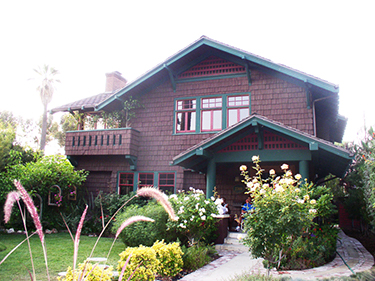WHAT IS AN HPOZ? Historic Preservation Overlay Zone
- Details
- Category: Our History
- Published on Tuesday, 07 January 2020 00:12
- Written by Laura Meyers
 Originally published in April/May 2015
Originally published in April/May 2015 Issue # 41
Many communities in CD10 are now or are in the process of becoming historic districts. With this designation, neighborhoods are able to preserve the distinctive character and beauty of their respective communities, which in turn will preserve the rich cultural and architectural history for future generations.
Historic districts in Los Angeles are defined by a special zoning ordinance called the Historic Preservation Overlay Zone (HPOZ), which is a City Planning Department designation added to our existing zoning regulations.
WHAT DOES AN HPOZ DO?
HPOZ designation recognizes the special importance of of a neighborhood, helping increase community pride and helping the neighborhood gain more importance and distinction in the eyes of many City employees.
The HPOZ historic designation applies only to the exteriors of buildings, and the site surrounding them. This includes features such as windows, doors, roofs, and porches, along with landscape and hardscape features such as driveways and walkways. HPOZ designation does not apply to any building interior and does not affect interior alterations.
HPOZ designation does NOT require that anyone spend money to restore a building or to make any alterations or improvements.
HPOZ designation can lower property taxes. Qualifying houses in HPOZs can apply to a state program (the Mills Act) which can reduce property taxes by up to 50%. HPOZ designation will NOT result in higher taxes.
HPOZ designation can increase the value of property. Studies have shown that over the long term historic districts have higher property values.
HPOZ designation can save homeowners money. Exterior alterations are reviewed by a neighborhood board experienced with fixing up and maintaining historic buildings. They can advise you on how to do the work, how to save money, and where to find resources for improvement.
HPOZ designation gives neighbors a greater say over new development, such as apartment or commercial buildings along the main boulevards.
HOW DOES AN HPOZ WORK?
Each HPOZ establishes a neighborhood design review board which is an advisory body to the City Planning Department. Each board consists neighbors and professionals who are knowledgeable about the history and architecture of the community, historic preservation requirements and, ideally, restoration construction techniques. The board members are appointed by various City entities.
The HPOZ is part of the normal building permit process. If a homeowner decides to start a project that requires a building permit, such as a new addition, or new windows, then the Planning Department and for many items the HPOZ board reviews and approves the project.
Each HPOZ has a Preservation Plan that includes guidelines that are commonly used by historic districts throughout the country.
HPOZs have different procedures depending on the type of work that is being proposed. In general, work that does not require a permit, such as routine maintenance, is not reviewed by the board. Regular work that needs a permit is reviewed by the board which makes a recommendation to the Planning Department. Minor changes to the exterior are handled by the board quickly. Major work, such as demolition, removal of the exterior of a historic building, or the construction of new buildings, requires a public hearing. All decisions can be appealed to the Planning Commission.
If you do live in or own property within an HPOZ, there are additional benefits. For example, you can utilize the State Historic Building Code when renovating your house, bypassing some local building codes that do not reflect the realities of older construction. And, you may not need to retrofit older toilets to comply with water conservation regulations upon sale of your house. But you should also be sure to get building permits for any construction work you do, since neighbors in HPOZs do tend to keep an eagle eye out for unpermitted construction.
It's been said that the owner of a historic house is only its steward for a short period of time, but its architecture can inform many future generations about the history of not just the building but also the people who together created the communities we call home. HPOZs help ensure those legacies.
Categories
-
Architecture
IF ONLY WALLS COULD SPEAK!
 People often think of history as an impersonal collection of facts and dates, a dusty inventory...
People often think of history as an impersonal collection of facts and dates, a dusty inventory...
-
Our History
BRIDGET "BIDDY' MASON: Founder of the First African American Methodist Church FAME
 Originally posted on blackdoctor.orgWhen we talk about Black History, we hear a lot of names over...
Originally posted on blackdoctor.orgWhen we talk about Black History, we hear a lot of names over...
-
In Memory Of
Barbara Morrison Celebrated Jazz Singer Dies at 72
 Barbara Morrison, a legendary singer in the Los Angeles jazz and blues music community, has died....
Barbara Morrison, a legendary singer in the Los Angeles jazz and blues music community, has died....
Today0
Yesterday10
Week10
Month206
All988534
Kubik-Rubik Joomla! Extensions
Yesterday10
Week10
Month206
All988534
Currently are 13 guests and no members online
Kubik-Rubik Joomla! Extensions




